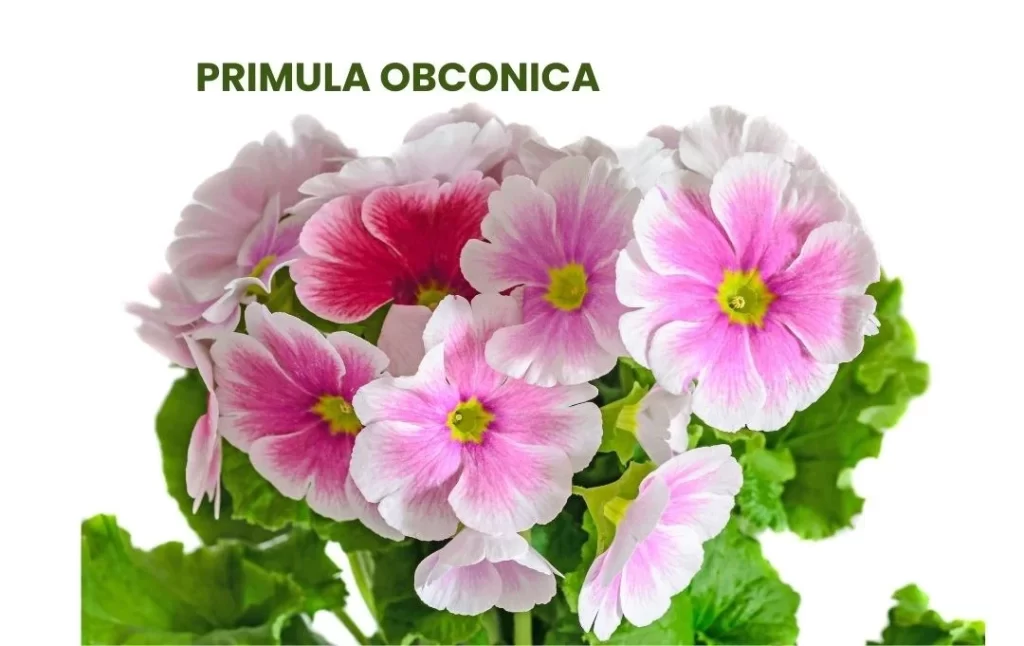Primula Obconica is a homeopathic remedy derived from the Primrose plant. It is used to treat various conditions, primarily those involving skin eruptions, rheumatic pains, and liver and spleen affections.

Table of Contents
ToggleSOURCE INFORMATION
Scientific Classification
- Kingdom: Plantae
- Family: Primulaceae
- Genus: Primula
- Species: Primula obconica
Primula obconica is a perennial herbaceous plant native to China and is also cultivated in other parts of Asia, Europe, and North America as an ornamental plant.
It typically grows in shaded areas and is characterized by its clusters of colorful flowers that bloom in various shades of pink, purple, white, or yellow.
The plant has distinctive glandular hairs on its leaves and stems.
Parts Used: In homeopathy, the whole plant of Primula obconica is used for medicinal purposes, including its leaves, stems, and flowers.
Preparation: To prepare the homeopathic remedy from Primula obconica, the fresh plant material is collected and processed according to homeopathic principles.
The plant material undergoes a series of dilutions and succussions (vigorous shaking) to create the potentized remedy used in homeopathic practice.
Interesting Facts
Poisonous Properties: The glandular hairs of Primula obconica contain a toxic substance that can cause skin irritation and allergic reactions in sensitive individuals.
Contact with the plant’s hairs or sap can result in dermatitis or other skin problems.
Ornamental Use: Despite its toxic properties, Primula obconica is widely cultivated as an ornamental plant for its attractive flowers.
It is commonly used in gardens, flower beds, and indoor plant displays.
Medicinal History: In traditional herbal medicine, Primula obconica has been used for various medicinal purposes, including treating respiratory ailments, skin conditions, and rheumatic pains.
However, its use in traditional medicine is limited due to its toxic nature.
Safety Considerations
- Due to its toxic properties, caution should be exercised when handling Primula obconica, especially for individuals with sensitive skin or allergies.
- In homeopathic dilutions, the toxic effects are greatly reduced, making it safe for therapeutic use under the guidance of a qualified homeopath.
DRUG PATHOGENESIS
- Primula Obconica primarily affects the skin, liver, spleen, and musculoskeletal system.
- It produces symptoms such as skin eruptions with intense itching, rheumatic pains, liver and spleen affections, and weakness.
- The remedy may cause intermittent symptoms, with manifestations often worse on the right side of the body.
KEY CHARACTERISTICS
- Skin Eruptions: Primula Obconica is indicated for various skin eruptions, including moist eczema, papular eruptions, urticaria-like eruptions, and blisters.
- Itching is typically intense, worse at night, and accompanied by redness and swelling.
- Rheumatic Pains: Patients may experience rheumatic pains around the shoulders, with cracking over joints and fingers.
- The palms may feel dry and hot.
- Liver and Spleen Affections: Pain in the liver and spleen, along with deep infiltration and tension of tissues, are common symptoms of Primula Obconica.
- Weakness: Patients may experience weakness, especially in the extremities, along with a paralyzed sensation.
- Face: Moist eczema, papular eruptions, and swollen eyelids may occur.
MODALITIES
- Aggravation: Symptoms may worsen at night, with itching and pain exacerbated by warmth. Symptoms may also be worse on the right side of the body.
- Amelioration: Cool applications and gentle motion may provide relief from symptoms.
WHAT ARE MODALITIES IN HOMOEOPATHY?
RELATIONSHIP WITH OTHER DRUGS
- Compare: Rhus Toxicodendron for similarities in skin symptoms and rheumatic pains. Fagopyrum may act as an antidote in cases of poisoning.
- Similar: Humea Elegans may exhibit similar skin symptoms.
DOSE
- Potency: Primula Obconica is available in various potencies ranging from low to high dilutions.
- Recommended Dose: A low to medium potency (e.g., 6C to 30C) is typically used for acute conditions, while a higher potency (e.g., 200C or higher) may be suitable for chronic conditions.
- Dosage: Generally, 3-5 pellets or drops of the selected potency are dissolved under the tongue or in a small amount of water, as directed by a qualified homeopath.
Frequently Asked Questions
Is Primula Obconica safe to use?
- When used according to homeopathic principles and in appropriate dilutions, Primula Obconica is considered safe for medicinal use.
Can Primula Obconica be used for conditions other than skin eruptions and rheumatic pains?
- Yes, Primula Obconica may also be indicated for liver and spleen affections, weakness, and other related symptoms.
How should I store Primula Obconica?
- Homeopathic remedies should be stored in a cool, dry place away from strong odors and sunlight to maintain their efficacy.
Can Primula Obconica be used during pregnancy and breastfeeding?
- It is advisable to consult a healthcare professional before using any homeopathic remedy during pregnancy or breastfeeding.
Meaning of Difficult Words
- Papular: Relating to or characterized by papules, which are small, solid, raised bumps on the skin.
- Urticaria-like: Resembling urticaria, a skin condition characterized by the sudden appearance of red, raised, and itchy welts.
- Febrile: Relating to or characterized by fever or elevated body temperature.
- Intermittency: The quality or state of being intermittent; occurring at irregular intervals.
In summary, Primula obconica, or Primrose, is a flowering plant with toxic properties that has been used in homeopathy for its therapeutic effects.
Despite its toxicity, it is valued for its ornamental beauty and has a history of use in traditional medicine for various ailments.
